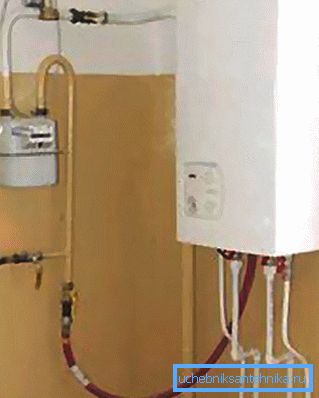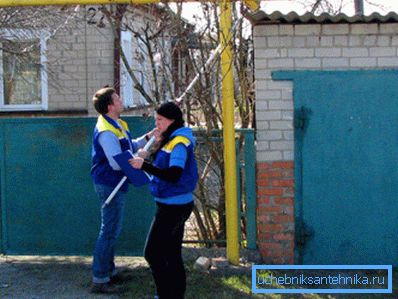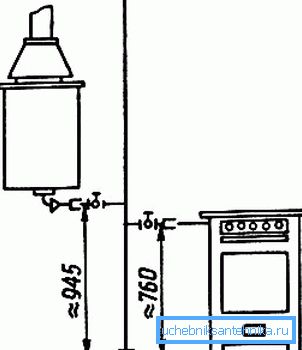Gas pipe - features, transport and installation
The gas pipeline in the house is necessary not only for supplying “blue fuel” to the cooking stove burners, but also for heating the dwelling if autonomous heating is installed. Thanks to him, the tenants also have hot water in the shower and in the kitchen. In this article we will consider its installation, as well as how they are interconnected - wall insulation and gas pipe.
Remember, the latter serves not only to supply fuel, but also to protect against leakage. Therefore, its installation should be carried out by specialized teams that have the appropriate access to such work.

General information
Below we consider the main options for steel products, which can most often be found in a private house and when laying a gas pipeline:
| Outdoor |
Price depends on the diameter and execution of the pipe. |
| Underground | In this case, recommended bitumenized pipes with jute sheath and threaded connection are recommended. Often you can find bell-shaped bitumen-coated and steel shells. |

Tip: if the gas pipeline runs indoors, you can neglect its insulation, since no condensate will form on it.
- Steel gas pipelines connect today with each other in the same way as water pipelines, i.e. with pipe fittings.
- At the same time, the bell-shaped pipes compact as well as the sewer pipes, and the lungs are welded.
- The sealant is a material based on hemp fibers impregnated with linseed oil and linseed oil.
Tip: do not use seals, which can further complicate the process of disassembling pipes, clogging the connection or otherwise obstructing it.
- To block the flow of fuel into the pipeline, use stopcocks, which can be closed with your own hands or with a special key. You do not need to compact them, as their body and cone are tightly interconnected.
- Placed in the basement of gas pipelines should not be closed, and the installation should be carried out, leaving gaps between the wall and them, using brackets and clamps.
- In the sections of the passage of pipes through the walls or in the places of their overlap, use an additional protective tube.

Tip: Pipe connections should be placed before or after the transition, and not in the pipe itself.
- In cinder block and cinder block, the pipeline should be protected, for example, with insulating special sheath or anti-corrosive paint.
- The pipes passing through the slots of the walls are necessary for the last hooks, and the grooves must be tightly sealed.

House gasification process
These works are time consuming and quite expensive.
But, if you have decided to gasify the site, we will briefly describe what you need for this.
- Find out who is the owner, passing near the gas line, so that when you meet, consider the possibility of tapping into the pipe.
- After receiving an affirmative answer, you will need to contact the project organization.. She must prepare a project to connect your home to a specific gas line.
- Then you should go to the installation organization, which will take over all the problems associated with the further installation of the pipeline. Also, this organization will put into operation this section of the line, so it must have the appropriate licenses for this type of work and approvals.
Advice: with the installation organization, all settlement operations are best carried out after the gas pipeline is handed over to the State Control bodies.
- Use gas for their own needs will be possible only after all the above steps..

Allowable SNiP
Gas is a potentially hazardous fuel, especially high-pressure pipelines. In this regard, there are certain rules governing the safe distances from them to a residential house, corresponding to SNiP 42-01-2002.
The higher the pressure in the pipe, the higher the potential danger of the system, so there is the following instruction indicating that the distance from the gas pipe to the building is between:
- the low pressure gas pipeline and the foundation of a residential building must be at least 2 m;
- buildings and pipes with an average pressure parameter - from 4 m;
- buildings and high-pressure systems - from 7 m.
The distance between the above-ground structure and the building of SNiP is not regulated. But, there is a certain security zone around the onshore gas pipeline, which is 2 m on each side, and it should also be marked.
Tip: during the construction of the house this parameter must be considered.
Also, construction rules allow to place the gas pipe relative to the door and window opening at a distance of at least 500 mm, and to the roof - from 200 mm. These recommendations are based on the requirements of sanitary standards and fire safety, their implementation should be mandatory.

How to move the gas pipe at the site
This is quite common when it was decided to carry out construction or repair work on newly acquired land. You may also need to change the laying of the pipeline in the apartment, for example, when reworking the kitchen.
For example, gas water heaters are often located uncomfortable, which will especially affect the creation of ergonomic space with the help of built-in appliances or cabinets. Such a standard placement prevents the placement of appliances and furniture and does not decorate the interior.

Although in suburban areas the pipes are usually laid underground, which reduces the danger of leaks, but maintenance also becomes more laborious. They are also placed on special supports installed directly on the site or along it. In this case, they are available for damage, but they are also easier to repair or replace.
Council: entrust installation and maintenance work on gas supply only to certified and highly qualified specialists. Remember, it is forbidden to independently carry out the transfer of the gas pipe at the site due to increased danger.

Before preparing for work you need:
- To prepare documentation for the gas company - the right to own and design the passage of the gas pipe in the section.
- Decide where to move the line. For example, heavy construction will be needed for underground work.
- Choose the right time to work, based on the climatic conditions of the region.
- Resolve all disputes between neighboring gas consumers.
Why do I need to transfer:
- Due to the unsuccessful location of the gas line, it is not possible to build a house in the chosen place. This is contrary to the norms of the law, which restricts the placement of buildings with the foundation next to the gas pipe laid.
- The pipeline is not placed as I would like the new owner of the site. In this case, a situation may arise when neighboring households are already connected to it, which must also be resolved as correctly as possible. In this case, do not do without the advice of a lawyer. Be prepared that the process may be delayed for many years, since the human factor will play a decisive role.

Conclusion
Many homeowners can not imagine how they would live without "blue fuel". However, not always his supply is able to satisfy all the needs of homeowners. Often there is a desire to change it, for example, when the gas pipe behind the refrigerator does not provide its normal maintenance.
All this can be done, but only under one condition - all work must be carried out by an organization that has the necessary licenses. The video in this article will help you find additional information on this topic.